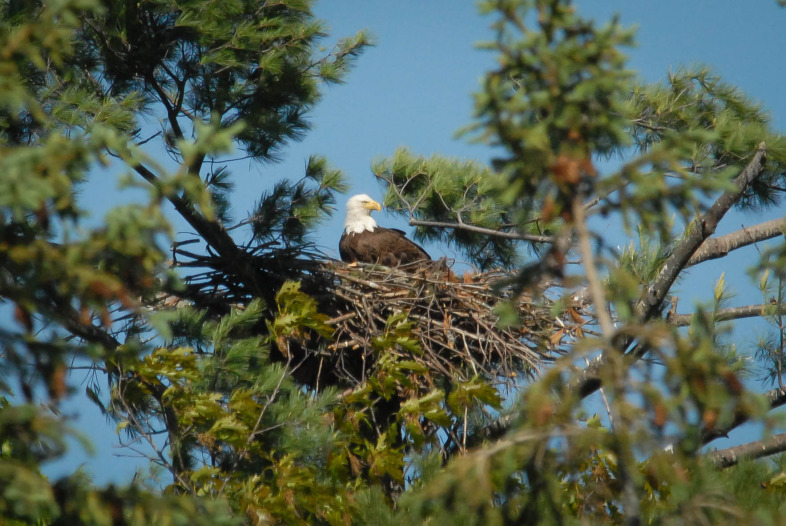
The Agency of Natural Resources is looking to protect critical habitat for some endangered species, such as nesting trees used by bald eagles. Courtesy of John Hall, Vt Fish & Wildlife Department.
MONTPELIER, Vt. – The Agency of Natural Resources will hold a meeting to discuss proposed changes to Vermont’s threatened and endangered species law. The meeting will take place August 5, 2015 at 6:30 p.m. at the Pavilion Auditorium, 109 State Street, Montpelier, Vt.
The changes to the law are intended to revise the language of the law to improve its effectiveness and to make the permit process more efficient and consistent for applicants.
Deb Markowitz, Secretary of Vermont’s Agency of Natural Resources, said “our goal is to better ensure the survival of vulnerable plants and animals while simplifying the process for landowners to get permits for activities that might impact these species.”
The Agency of Natural Resources has proposed two major changes to the law. The first change would allow biologists to identify and protect critical habitat that threatened and endangered species need to survive. Only clearly defined critical habitats, which are limited in area, would be designated for specific species through the rulemaking process. This process will involve public notice, at least one hearing, and an opportunity to comment.
“Vermont’s endangered species law has changed little since it was first written in 1981,” said Steve Parren, Wildlife Diversity Program Manager for Vermont Fish & Wildlife. “We feel these changes are necessary to effectively protect species that are struggling to thrive in our state.”
Parren cited several examples that might be considered for critical habitat designation. “Bald eagles often use the same tree to nest year after year, so cutting down the nest tree when the eagle is not actively nesting there could prevent it from nesting successfully in the future,” said Parren. “We would also want to avoid activities near caves that contain endangered Indiana bats that might impact the cave conditions needed by the bats for hibernation”
The second proposed change to the law would allow the Agency of Natural Resources Secretary to issue general permits to cover routine activities such as display of specimens for education. This change would allow the Secretary to fashion permits that protect threatened and endangered species and provide greater efficiency in the permitting process.
Finally, the Secretary and permittees have greater flexibility to fashion mitigation strategies to benefit the long-term survival of a species.
“We invite conservationists, landowners, business owners, and anyone who is interested in the proposed updates to the law to attend the meeting to learn more, ask questions, and let us know what they think,” said Parren.

Sir or Madam:I had an unfamiliar bird sighting two or three weeks ago. No friends can help. Could you please suggest what the following description might be? From Lyman Point in White River, a pale bird which I first mistook for a ring-billed, possibly even herring, gulll, flying down White R. towards the Conn. R. Wings however were narrower, sabre-like, actually like a small albatross. Flight was gull-like and somewhat labored, while its call was, in time with wingbeats a note repeated continually, higher pitched and less melodious than herring gull’s. The bird seemed larger than a gull, but size is hard to judge without objects for comparison. I shall be very grateful for any assistance. Peter Wackell
Peter – it’s always a challenge to identify a bird from a written description, but I wonder if you might have had a tern species, most likely either a Common or Caspian. Judging from your assessment of its size, I’m guessing Caspian. See what you think: http://www.allaboutbirds.org/guide/Caspian_Tern/id. It’s quite early for that species in the Upper Valley (and it’s uncommon at best), but certainly possible. The only thing that concerns me is your description of voice. If you listen to the recording on the above All About Birds web site, I’m not sure it fits your description of being “higher pitched and more melodious than a Herring Gull”. Let us know if this helps refine your identification!
Dear Chris, The bird I saw was surely not a tern, its tail being gull-like; also much larger. The call while flying was not more melodious than any gull’s but less. Perhaps I misspoke.Quite an unusual sighting I believe, for although shorebirds are often hard to distinguish differentially, i.e., as to similar species, this sighting was not like any I have seen before; and I lived most of my life in eastern Mass. Is there any remote chance of an albatross? The Audubon Encyclopedia of birds says, 1. one species sometimes travels upriver and into fresh water, and also that southern species are occasional in northern waters. We are having strange weather, and of course, 2. birds can be carried by anomalies of weather anywhere if the sea stays put. Incidentally, I saw a giant swallowtail on Monarda by the Hartford town hall on August 5. Peter Wackell